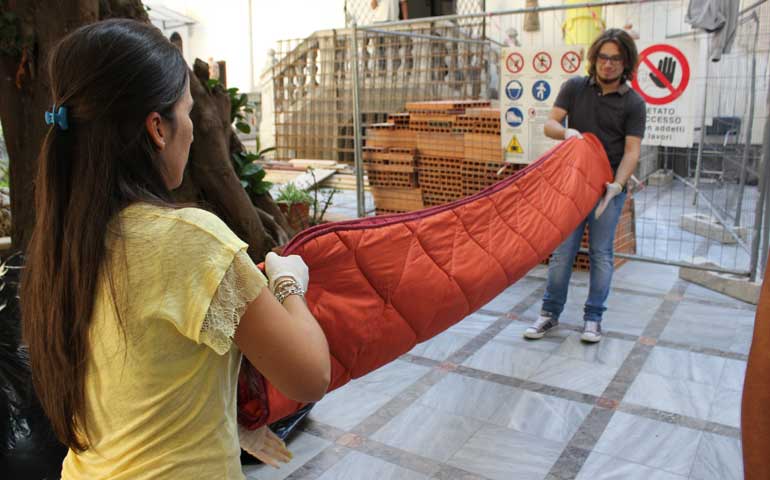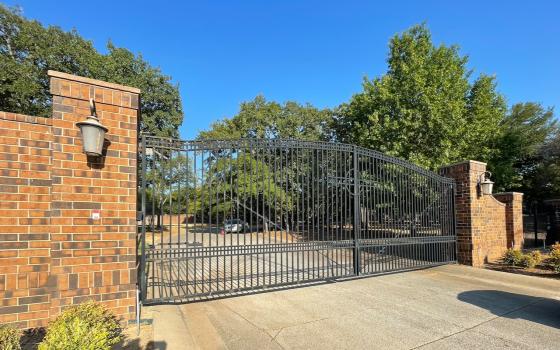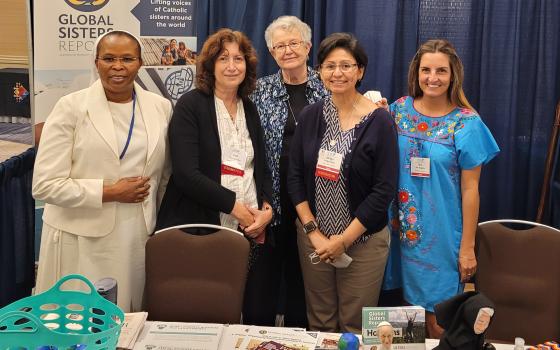
Volunteers fold blankets at a reception center for migrants in a church in Palermo, Sicily, in Italy. (Photos by Megan Sweas)
August in Italy is a usually a time for rest and relaxation. But on one Saturday in the summer of 2013, beachgoers in Catania, Sicily, found a boat full of migrants that had crashed off the city's shore. As news spread throughout social media, a group of Catania's youth knew what they needed to do.
Just one month earlier, Pope Francis had used his first papal trip outside Rome to call attention to the flood of immigrants crossing the Mediterranean. In Lampedusa, a small Italian island about an hour plane ride south of Sicily, he denounced the world's inaction in the face of the most deadly migration path in the world. More than 22,000 have died attempting to reach Europe since 2000, according to the International Organization for Migration.
"We have fallen into a globalization of indifference," Francis said. "We are accustomed to the suffering of others; it doesn't concern us; it's none of our business."
Already engaged in social issues, the youth of Catania's Community of Sant'Egidio were impressed by the pope's words and deeds. Still, the arrival of migrants on Europe's shores seemed like a remote issue, both physically and mentally, said Mbaye Gueye, a university student in the group. So when a boat of migrants ended up in Catania so soon after the pope's speech, it felt like a sign, he said.
Fifteen youth interrupted their summer fun to gather food and clothing from friends and meet the migrants on the beach. They found people their age and younger. Six migrants had died in the accident. One unaccompanied minor told them that his grandmother put him on the boat and said, "Go and save yourself."
"We went there to create a welcoming climate," Gueye said. "When you're in this situation, do you really want food, clothes or something else?"
Their idea of "something else," Gueye and his friends found, was a vision of fraternal responsibility preached by the pope.
In the past year, the Italian church has had plenty of opportunities to put this vision into practice. In 2014, some 160,000 migrants crossed the Mediterranean to Italy, up from 42,000 in 2013.
Pope Francis effect
Francis' efforts to refocus the church on social issues have coincided with the surge of migrants taking the perilous trip across the Mediterranean. In October 2013, within months of his trip to Lampedusa, 360 migrants died when their boat shipwrecked off the island's shore.
Both the pope's moral leadership and the tragedy were credited with pushing Italy to start a search-and-rescue mission in the Mediterranean called Mare Nostrum, or "Our Sea." Despite the Italian navy's best efforts to rescue migrants, the United Nations' refugee agency estimates that more than 3,400 people died in crossing attempts in 2014.
In his November speech to the European Parliament, Francis urged European leaders not to "allow the Mediterranean to become a vast cemetery." Italy was only able to sustain Mare Nostrum through the end of 2014 and its European Union replacement has one-third of the budget.
Some European politicians argue that search-and-rescue missions encourage risky migration. But the migrants are so desperate that not even winter weather has slowed the crossings.
"The main problem is that there are wars in Africa and Middle East," said Paola Monzini, an independent consultant who has worked with the U.N. and other international organizations on migration and trafficking issues. "Twenty years ago, 10 years ago, people coming by boat were economic migrants, but now 90 percent are people escaping from very difficult situations."
The Mediterranean crossings are not new. While most date the current migration "emergency" back to the pro-democracy uprisings in North African countries in 2011, Salesian Fr. Enzo Volpe said it started more than 20 years earlier. Santa Chiara, where Volpe is director of the Salesian community, began welcoming boat migrants in a poor neighborhood in Palermo, Sicily, in the late 1980s.
Santa Chiara is a small church filled with rare yellow marble and notable artwork. Inside its auditorium, a large hole in the floor reveals a section of Palermo's Punic walls, though archeologists abandoned the excavation site seven years ago when funding ran out. Sicilians point to their history with pride when explaining why they welcome migrants. Greeks, Romans, Arabs and Normans have all left their mark on the island.
As immigrants started coming to Italy by boat in the 1980s, the church's buildings became dormitories for people with nowhere else to go. The courtyards were like "the central square of a little town," especially on Sunday, Volpe said.
The buildings no longer house migrants because they are not structurally stable, but the church remains the center of a diverse immigrant neighborhood. Today, Santa Chiara's courtyards are full of children in its day care and afterschool programs. In a lively soccer game, a boy with dark black skin yelled in a thick Sicilian accent to his teammates.
"They were born here, so they're Sicilian," Volpe said. "These kids are from all over."
Because it was the first group to respond to migrants' needs, the Catholic church became the authority on immigration issues in Italy. Many estimate that the church is responsible for half of the service for migrants in Italy, and Caritas Italiana (an organization similar to Catholic Charities in the U.S.) claims to be the main organization working on immigration. Francis' exhortations are backed by lobbying by multiple Catholic organizations and their secular partners.
"Without the church, I don't know how [the migrants] could survive," Monzini said.
Off the boat
Next door to Santa Chiara, Caritas Palermo has transformed offices into dorms to meet the current demand for shelter. "With this emergency, we're turned upside down," said Comboni Missionary Sr. Valeria Gandini, whose office had temporarily become a man's bedroom. From May to October 2014, Caritas Palermo took in some 3,000 of the 5,000 migrants arriving in the city.
A few blocks away, a decommissioned church served as the first stop for many migrants. The nave fit cots for 100 migrants, who typically stay a day or two before going out on their own or being transferred to refugee camps throughout Italy.
A Syrian family had a room to themselves. They had arrived 12 days earlier and within two days, the mother gave birth to a son, the center's social worker told Gandini, as she cooed over the baby. Adel Al Sawaf, the baby's father, spoke little English and even less Italian, but communicated to the two that he and his family wanted to go to Germany.
You'll have to leave soon before the Italian police ask for your fingerprints, Gandini said in slow, deliberate English.
EU regulations require that refugees apply for asylum in the country where they first enter Europe. In order to make it to Northern Europe, migrants have to travel clandestinely through Italy.
Most migrants, particularly Syrians, don't want to stay in Italy. The depressed economy doesn't provide enough jobs for Italians, let alone newcomers, while the refugee reception system is overcrowded, underfunded and corrupt. Mafia leaders were arrested in November for embezzling funds intended for migrant services. "Do you have any idea how much I make on these immigrants?" one was caught saying. "Drug trafficking is less profitable."
As a member of the watchdog group Borderline Sicily, Lay Comboni Missionary Alberto Biondo has visited many reception sites in western Sicily. Asylum seekers are frequently denied their rights under international law. Even a priest was arrested for requesting money and sexual favors from migrants. Yet, many Catholic organizations are doing all they can for migrants, sometimes even helping them move on, Biondo said.
Gandini tried to reassure Al Sawaf that Caritas would help him and his family. Thin with a short scraggily beard, Al Sawaf mimed guns. Problem, Libya, no money, he said, speaking in phrases. He took out his phone to show a video from their boat ride, his pregnant wife leaning up against the side of the boat with no more than a black inner-tube and his young daughter sitting in an adult's lap with no life jacket.
The vast number of migrants and the speed at which they come and go don't allow Caritas staff and volunteers to get to know them well, Gandini said, but the Catholic approach is to respond to individuals' needs.
On a policy level, this means that the church wants to see EU regulations changed to allow asylum seekers more freedom to go where they may already have family or a support structure. Ideally, more generous immigration policies, through refugee resettlement or more visas, would allow refugees to make it to Europe without risking their lives at sea.
Without a unified European reception system, though, Italian authorities simply look the other way as tens of thousands of migrants continue their journeys north by bus, train or taxi, aided by both smugglers and people of goodwill.
Stuck in Rome
From first reception centers like the decommissioned church in Palermo, migrants are taken to large, overcrowded refugee camps, where they can live while applying for asylum, a process that can take a year. But the camps are open, allowing migrants to come and go as they please.
After a week in a refugee camp in Southern Italy, two young men decided to leave for Rome. Redone and Bayiam traveled from Eritrea together, and were now living on the streets near Termini, the central train station in Rome.
An Eritrean nun brought them food, and they had each other -- for the moment. Redone, 20, planned to travel to England. After Syrians, Eritreans are the second most common nationality crossing the Mediterranean into Italy. A brutal dictatorship and mandatory military service qualifies them for asylum in Europe. Redone's older brother made the same trip to England five years earlier, also when he was 20.
Bayiam, though, had been forced to give his fingerprints at the camp in Southern Italy. He would have to stay and wait for asylum. "I hate Italy," he said, using Redone as his translator.
He does not have to look far to justify his pessimism. All around Termini, migrants loiter as if waiting to go someplace. In nearby parks, they sit alone or in groups in the shadows of Roman ruins. Young African men walk around with ear buds in and a plastic bag containing their possessions, while those who've been in Italy for years hawk purses, umbrellas or small trinkets. Many migrants end up jobless and homeless.
Maiga Issaka, from Mali, was homeless while awaiting a spot in the government reception system. He slept alongside other migrants and Italian homeless outside the train station. The police wake them up before dawn, so that tourists boarding airport buses don't see them, Maiga said. He cut through a back tunnel to avoid the commuters, ashamed of his uncleanliness. He hid his cardboard and bedding behind some scaffolding -- until the police found it and threw it away.
Then, the daily cycle of survival started. Walking around Termini's neighborhood, Maiga pointed to doors where breakfast, shelter or a shower could be found at churches and convents. Sometimes a piece of paper taped to the door indicated hours. At other places, you just had to know where and when to show up.
In the afternoon, homeless migrants find their way to Jesuit Refugee Service's Centro Astalli, which serves up to 400 meals a day. Centro Astalli provides legal, medical and psychological assistance; shower facilities; and a mailing address that the homeless can use to apply for asylum.
Centro Astalli also operates four government-funded homes for refugees in Rome, part of the System of Protection for Asylum Seekers and Refugees (SPRAR). After their asylum application has been recognized, refugees can move from the large camps to SPRAR, where they receive individual attention and an integration project, including language and job training.
It's a quality program, said Chiara Peri, project manager for international relations at Centro Astalli. But "even when you are in a center for six months or maximum one year at the SPRAR, it's not enough to become fully independent."
Migrants often take odd jobs, work for slave wages in agriculture, or are pushed into prostitution. Even if they find low-wage work, it's difficult to save up for an apartment.
A half a dozen refugees have found housing, thanks to two religious congregations that volunteer guest homes to Centro Astalli. Early in his papacy, Francis visited Centro Astalli and asked religious to open their empty spaces to refugees.
"Our idea is to offer a little support for the last phase of integration, which is the weakest point of the system," Peri said, acknowledging that Centro Astalli doesn't intend to create a systemic solution to refugee homelessness. "This can only be a responsibility of the state."
Maiga would still be homeless if it weren't for the Joel Nafuma Refugee Center at St. Paul's Within the Walls, another church where migrants can hang out during the day and access services. St. Paul's, the American Episcopal church in Rome, agreed to give him a room in the rectory after his time in the government reception system ended, hiring him to provide security.
Other migrants pool together their resources to rent cheap rooms on the outskirts of Rome or take over abandoned buildings with the help of Italians.
Redone and Bayiam spend their days near an office building occupied by 400 Eritreans, Ethiopians and Sudanese. All residents must have refugee status, excluding recent arrivals like them.
The "Palace," as residents call it, is one of several occupied buildings around Rome. An Italian association helps migrants scout and take over such buildings, and the government rarely bothers to cut off electricity or services.
"They know our problem; they know that we're crying for life; they know our difficulties. I think they can accept it," a member of the Palace's leadership committee said about the government's inaction. Still, he asked not to be named because occupation is illegal. The council sets and enforces basic rules of decent behavior to ensure they remain good neighbors. "From my point of view, it's going well," he said.
Weary welcome
In another area where migrants live in abandoned buildings, Italians are less forgiving. Last fall, anti-immigrant riots broke out for a week in a largely immigrant neighborhood on the outskirts of Rome. Francis called for parishes to become places of dialogue between Italians and migrants in his weekly address following the riots.
Thanks in part to the pope, anti-immigrant sentiment is generally down compared to 2011, the last time Italy saw a great increase in migrants. "Our idea was that we have double the people [compared to 2011], we're probably going to have double the problems, but this has not happened," said Oliviero Forti, head of immigration for Caritas Italiana.
But even without outward signs of hostility, migrants largely feel isolated. The leader of the Palace points to the occupied buildings as a sign of the lack of integration. We knock on the door, he said, "but if they don't open it, we have to come back to our society and live together like this."
In Catania, too, many have grown frustrated with the constant state of emergency.
Still, about 200 youth involved in the Community of Sant'Egidio have continued to organize online to bring food, clothing and love to the migrants. The authorities call Sant'Egidio first when a boat is on its way, Emiliano Abramo, an adult leader of Sant'Egidio's youth group, said with pride. But it has caused a generational conflict.
Parents tell their children to think about their own futures, he said, but the Gospel tells them to love others as you love yourself.
The Gospel wins, Abramo said. "When you think about people who can help others, you think about politicians and people who have money, but these young people are the real soul of Sicily."
[Megan Sweas is a freelance journalist based in Los Angeles. Reporting for this article was supported by a grant from the International Reporting Project.]






